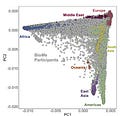Response To Genetic Ancestry Paper
"Getting Genetic Ancestry Right for Science and Society"
Yesterday this paper was published in Science:
Lewis, A.C., Molina, S.J., Appelbaum, P.S., Dauda, B., Di Rienzo, A., Fuentes, A., Fullerton, S.M., Garrison, N.A., Ghosh, N., Hammonds, E.M. and Jones, D.S., 2022. Getting genetic ancestry right for science and society. Science, 376(6590), pp.250-252.
As I have previously discussed, the concept of genetic ancestry, and the ability for genetics researchers to tie individuals into both geographical and cultural groups has made the liberal edge of modern academia extremely uncomfortable. Papers that can pinpoint the group and place of origin of an ancient fossil are inherently suspicious to these activists, since it offers the opportunity for older, more racialist tinged ideas to get a hearing within modern science - or at least, that is their concern.
This paper takes full aim at the notion of 'continental ancestry’. In their own words:
Racial classifications have often taken continents as boundaries between human groups; thus it is not surprising that racial categories and continental ancestry categories are often confounded. Whenever continental ancestry categories are used, the risk is high that a misconception of race as biological will re-enter through the backdoor.
What they mean by continental ancestry is the broad groupings of humans under terms like ‘South Asian’, ‘European’ or ‘African’, whereby someone’s genetic data can be clustered around others which match a general region or continent. Their argument falls into two main points, which they outline:
Genetic ancestry is complex, so complex that we don’t have a full and clear working definition.
People have mixed backgrounds, so can’t and shouldn’t be easily categorised when actually, we all fall on a continuum.
These are both so preposterous as serious arguments I am surprised the paper was published. A quick check through the author list shows that the main contributors are bioethicists, sociologists and researchers in public health equity and similar fields. Likewise their bibliography, a mere 15 references, hardly diving into the complexities and nuances of human genetics, is a list of politicised titles - “Race and Genetic Ancestry in Medicine — A Time for Reckoning with Racism” or “Hidden in Plain Sight — Reconsidering the Use of Race Correction in Clinical Algorithms”.
To rip the paper apart line by line isn’t necessary, it is merely sufficient to compare the study of human genetics with other fields where phylogeny and ancestry is primary, say linguistics or evolutionary biology. In any discipline where your object of study evolves naturally and is contingent on what went before, we end up with the problem of classification. It is well known in biology that even a simple category like ‘species’ is fraught with definitional problems. To that end we create hierarchies of classifications, which allow us to move from the micro to the macro. For example, the taxonomic ranking system in biology:
Life, Domain, Kingdom, Phylum, Class, Order, Family, Genus, Species
We know that each species is a combination of contingent events, but that doesn’t stop us using bigger and smaller scales to help group and categorise. Likewise, geneticists DO NOT just operate at the level of continental ancestry. From the micro scale of individual haplogroups and unique genetic mutations or polymorphisms, to the macro scale of broad sweeping clusters like ‘African’, genetics operates at every level. If this didn’t work, then archaeology would not be able to tease apart and interrogate data from ancient fossils, placing human remains into families of maternal and paternal DNA. That they can tells us papers like this are being disingenuous.
This diagram is meant to highlight to the readers that we shouldn’t take seriously the idea of continental ancestry, because look - all the grey dots form a continuous blob. But they don’t, they form streams between poles, which reflects the broad, imprecise, crude, but ultimately meaningful distinction between people from different continents. No-one is suggesting that humans form entirely discrete, bounded and independent units, but this kind of weak sophistry is designed to help muddy and confuse. This paper WILL be cited by others attempting to obfuscate and befuddle, and most won’t read the details of these arguments, but merely cite it as an authority.
It falls to us, researchers and amateurs alike, to rebuke and present a defence of meaningful categorisation in the face of politicised science. We must be prepared to call this nonsense out and insist on rigorous and exacting standards. That this paper was published at all is an indictment on many fields, it wouldn’t pass for a semi-decent undergraduate essay.
Sadly we should expect more like this and we should expect to see moves within journals and conferences to clamp down on language and concepts that they find distasteful. Perhaps for those of us concerned with real research and science, we should be finding one another and looking for a way out of this morass?




I’m glad you addressed this paper. That diagram has been irritating me. What exactly is the BioMe sample set? Given the ideological agenda, it seems that they could flood the databank with mixed-race individuals to create an impression of less clustering than if randomly sampled in various ancestral lands.
'twas agitprop like this that didn't have me understand my own east african bronze age anatolian hybridity till very recently